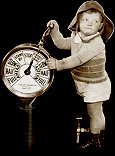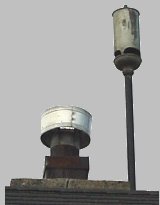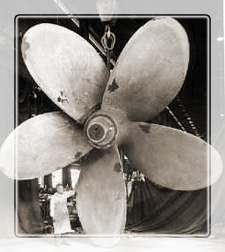|
|
Just a bit o' fun! We're going to toot our own horns one after the other right after the venerable Kennedy Steam Whistle mounted atop the Marine & Rail Museum does it's twice daily blow. Kennedy's foundry, later Black Clawson Kennedy, was a large industrial firm formerly across the street from the museum. They made ship propellors of all sorts, even up to over 20 feet in diameter. All Russel boats had Kennedy props. |
Source: http://www.marinerail.com/page.php?page=whistle
The whistle--a working artifact--now sits atop the roof of the Marine & Rail Museum, its new home. Norm Meneray generously donated the whistle to the museum; Wayne King and Robert King donated their equipment and expertise in memory of their father, E.C. King. The Kennedy Whistle once signaled the start of the workday at 7 a.m. A short blast would sound at five minutes before both 12 noon and 5 p.m. to allow employees to conclude their present projects. A long blast then indicated the lunch break at 12 noon and the end of the workday at 5 p.m. Official dedication ceremonies were held on the last day of school in June 2002, signaling the start of the students' summer vacation. The whistle remained mute for several months while the Museum underwent alterations to host an independently functioning whistle. Compressors and air reservoir tanks are now located in the Museum basement. Electrical work was done and a timer installed to automatically control the timing and regularity of the whistle. The original whistle was powered with steam from the machine shop boilers. During the summer when the boilers weren't operational, and in later years when Kennedy's converted to gas, the whistle was activated by an air compressor. The whistle started signaling the lunch hour at noon and the end of the working day at 5 p.m., again, on December 23, 2002 at a ceremony held in memory of E.C. King by his two sons, Wayne and Robert. It was the 19th anniversary of E.C. King's passing. |
Source: http://www.marinerail.com/page.php?page=kennedy
After his death in 1885, his son Matthew added a steel factory. By 1911, it employed 150 people and manufactured turbines, mill gearings, steel casting and propellors. By 1916, two rival companies had been swallowed up by Wm. Kennedy & Sons: Owen Sound Iron Works and Malleable Iron. One of William's sons, John, was a civil engineer and designed the Montreal and Halifax harbours. John was knighted in 1916 by King George V for "his devoted service to marine and rail transportation in Canada", becoming Sir John Kennedy. In 1924, D.J. Kennedy with fellow businessman, W.J. Christie, enlisted the support of several Owen Sound companies to donate the sum of $5000 apiece to the erection, purchase and operation of a grain elevator in the Owen Sound harbour. It was an attempt to revitalize the harbour. It was the first step toward the construction of the grain elevator which was completed in the fall of 1925. In October 1925, homage was paid to Matthew as he celebrated his 80th birthday. In December of the same year, a column in the Owen Sound Sun Times entitled, "Pioneers in Industry" honoured both Matthew, President of Wm. Kennedy and Sons Limited, and D. J. Kennedy, Vice President. Matthew served as mayor of Owen Sound three times during his lifetime. Kennedy's Foundry manufactured and supplied propellors for hundreds of ships worldwide, on every Canadian naval ship and on most merchant marine vessels. During World War I and World War II, operations were dedicated almost solely to the war effort. It remained a family-owned business for almost one hundred years until it was sold in 1951 to a British firm. The company underwent another ownership change in 1961 when it was purchased by Black Clawson of Hamilton, Ohio, which manufactured the heavy machinery required for the pulp and paper industry. It was necessary to expand the building to house this huge operation. Black Clawson Kennedy closed its doors in 1997. Today, no physical evidence remains of the factories the Kennedys built as the buildings were demolished. The Kennedy's historical contribution to Owen Sound's development, however, lives on in the collection at the Museum. |


 The Kennedy whistle at Wm. Kennedy and Sons Ltd. was once the unofficial timekeeper for much of the City of Owen Sound. Located prominently on the waterfront and with a workforce of close to 800 at one time, Kennedy's was at the heart of the city.
The Kennedy whistle at Wm. Kennedy and Sons Ltd. was once the unofficial timekeeper for much of the City of Owen Sound. Located prominently on the waterfront and with a workforce of close to 800 at one time, Kennedy's was at the heart of the city.
 William Kennedy, the founder of Wm. Kennedy & Sons, came to Upper Canada in 1831. In 1856, he travelled to Owen Sound to install machinery for Harrisons' Woolen & Grist Mill. A millwright by trade and trained in Scotland, Kennedy decided to stay in Owen Sound. By 1863, he was the proud owner of a two-story sash and door factory and a machine shop.
William Kennedy, the founder of Wm. Kennedy & Sons, came to Upper Canada in 1831. In 1856, he travelled to Owen Sound to install machinery for Harrisons' Woolen & Grist Mill. A millwright by trade and trained in Scotland, Kennedy decided to stay in Owen Sound. By 1863, he was the proud owner of a two-story sash and door factory and a machine shop.